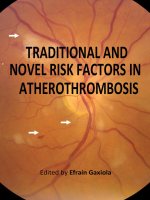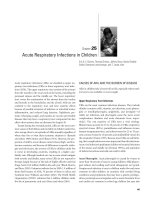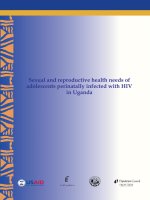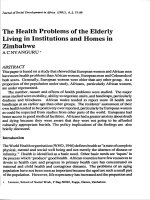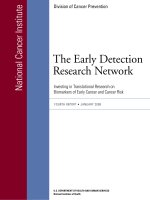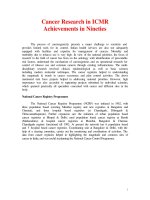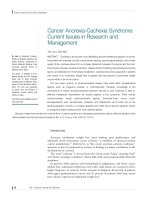RECENT TRANSLATIONAL RESEARCH IN HIV/AIDS ppt
Bạn đang xem bản rút gọn của tài liệu. Xem và tải ngay bản đầy đủ của tài liệu tại đây (20.09 MB, 578 trang )
RECENT TRANSLATIONAL
RESEARCH IN HIV/AIDS
Edited by Yi-Wei Tang
Recent Translational Research in HIV/AIDS
Edited by Yi-Wei Tang
Published by InTech
Janeza Trdine 9, 51000 Rijeka, Croatia
Copyright © 2011 InTech
All chapters are Open Access distributed under the Creative Commons Attribution 3.0
license, which permits to copy, distribute, transmit, and adapt the work in any medium,
so long as the original work is properly cited. After this work has been published by
InTech, authors have the right to republish it, in whole or part, in any publication of
which they are the author, and to make other personal use of the work. Any republication,
referencing or personal use of the work must explicitly identify the original source.
As for readers, this license allows users to download, copy and build upon published
chapters even for commercial purposes, as long as the author and publisher are properly
credited, which ensures maximum dissemination and a wider impact of our publications.
Notice
Statements and opinions expressed in the chapters are these of the individual contributors
and not necessarily those of the editors or publisher. No responsibility is accepted for the
accuracy of information contained in the published chapters. The publisher assumes no
responsibility for any damage or injury to persons or property arising out of the use of any
materials, instructions, methods or ideas contained in the book.
Publishing Process Manager Silvia Vlase
Technical Editor Teodora Smiljanic
Cover Designer Jan Hyrat
Image Copyright Sebastian Kaulitzki, 2011. Used under license from Shutterstock.com
First published October, 2011
Printed in Croatia
A free online edition of this book is available at www.intechopen.com
Additional hard copies can be obtained from
Recent Translational Research in HIV/AIDS, Edited by Yi-Wei Tang
p. cm.
ISBN 978-953-307-719-2
free online editions of InTech
Books and Journals can be found at
www.intechopen.com
Contents
Preface IX
Part 1 Pathogenesis and Epidemiology 1
Chapter 1 HIV-1 Glycoprotein Immunogenicity 3
Fahd Benjelloun, Christian Genin and Stephane Paul
Chapter 2 Characterisation, Evaluation
and Clinical Significance of Latent HIV-1 Reservoirs
and Therapeutic Strategies for HIV Eradication 43
James Williams, Sarah Fidler and John Frater
Chapter 3 The Changing Trends of HIV Subtypes
and Its Implication on Mother-to-Child Transmission 71
Michael Kiptoo
Part 2 Pharmacology and Host Interaction 87
Chapter 4 Transport Mechanisms of Nucleosides and Nucleoside
Analogues ReverseTranscriptase Inhibitors in the Brain 89
Zoran B. Redzic and Sonja Misirlic Dencic
Chapter 5 Interaction of Traditional Remedies
Against HIV, Nutrients and ARVs 111
Eugenia Barros
Part 3 Opportunistic Microbial Infections 127
Chapter 6 Syphilis in Men Infected with
the Human Immunodeficiency Virus 129
Francisco Rodríguez-Gómez, Hortencia Cachay,
David Chinchón, Enrique Jorquera and
Emilio Pujol
Chapter 7 Rifamycin Use in HIV-Infected
Patients with Tuberculosis 145
Aline Bergesch Barth, Eric Free Egelund
and Charles Arthur Peloquin
VI Contents
Chapter 8 Reversal Reaction as a Manifestation of Immune
Reconstitution Inflammatory Syndrome 161
Vinicius Menezes, Anna Maria Sales,
José Augusto Nery, Ximena Illarramendi, Alice Miranda,
Maria Clara Galhardo and Euzenir Sarno
Part 4 Laboratory Diagnosis 177
Chapter 9 The HIV Seronegative Window Period:
Diagnostic Challenges and Solutions 179
Tamar Jehuda-Cohen
Chapter 10 Pearls and Pitfalls of HIV-1
Serologic Laboratory Testing 203
Jiasheng Shao
, Yunzhi Zhang, Yi-Wei Tang and Hongzhou Lu
Chapter 11 Surgical Pathology in HIV Infection
in the Era of Antiretroviral Therapy 213
Mónica Belinda Romero-Guadarrama
Part 5 Antiretroviral Therapy 235
Chapter 12 Simplification of Antiretroviral Therapy (ART) 237
Maria Paloma Geijo Martinez
Chapter 13 Highly Active Antiretroviral Therapy (HAART)
and Metabolic Complications 253
Beth S. Zha, Elaine J. Studer, Weibin Zha,
Philip B. Hylemon, William Pandak and Huiping Zhou
Chapter 14 Future Perspectives in NNRTI-Based Therapy:
Bases for Understanding Their Toxicity 275
Ana Blas-García, Nadezda Apostolova and Juan V. Esplugues
Chapter 15 Antiretroviral Therapy
and HIV-Associated Neurocognitive Disorders 295
Cagla Akay and Kelly L. Jordan-Sciutto
Part 6 Special Clinical Cares 323
Chapter 16 Special Considerations in the Management
of HIV Infection in Pregnancy 325
Chi Dola, Sean Kim and Juliet Tran
Chapter 17 HIV-1 Treatment-Experienced Patients:
Treatment Options and Management 343
Gail Reid and Richard M. Novak
Contents VII
Chapter 18 InforMatrix Nucleoside/Nucleotide Reverse
Transcriptase Inhibitors “Backbones” 361
Gerrit Schreij and Rob Janknegt
Part 7 New Therapy Strategies 385
Chapter 19 Crippling of HIV at Multiple Stages with Recombinant
Adeno-Associated Viral Mediated RNA Interference 387
Ramesh B. Batchu, Oksana V. Gruzdyn, Aamer M. Qazi,
Assaad Y. Semaan, Shelly M. Seward, Christopher P. Steffes,
David L. Bouwman, Donald W. Weaver and Scott A. Gruber
Chapter 20 Cell-Delivered Gene Therapy for HIV 405
Scott Ledger, Borislav Savkovic, Michelle Millington, Helen Impey,
Maureen Boyd, John M. Murray and Geoff Symonds
Chapter 21 Gene Therapy for HIV-1 Infection 431
Lisa Egerer, Dorothee von Laer and Janine Kimpel
Chapter 22 HIV-Screening Strategies for
the Discovery of Novel HIV-Inhibitors 457
María José Abad, Luis Miguel Bedoya and Paulina Bermejo
Part 8 Vaccine Development 469
Chapter 23 HIV Vaccine 471
Alexandre de Almeida, Telma Miyuki Oshiro,
Alessandra Pontillo and Alberto José da Silva Duarte
Chapter 24 Towards a Functional Cure for HIV Infection:
The Potential Contribution of Therapeutic Vaccination 493
Maja A. Sommerfelt
Part 9 Beyond Conventional 511
Chapter 25 Micronutrient Synergy
in the Control of HIV Infection and AIDS 513
Raxit J. Jariwalla, Aleksandra Niedzwiecki and Matthias Rath
Chapter 26 Substance Abuse Treatment Utilizing Medication
Assisted Treatment as HIV Prevention 527
Thomas F Kresina, Robert Lubran and Laura W. Cheever
Chapter 27 The Pertinence of Applying Qualitative
Investigation Strategies in the Design
and Evaluation of HIV Prevention Policies 549
Carmen Rodríguez, Teresa Blasco,
Antonio Vargas and Agustín Benito
Preface
A translational research serves a bench-to-bedside 'translation' of basic scientific
research to practicable diagnostic procedure and therapies with meaningful
improvements in physical, mental, or social health outcomes. To improve human
health, scientific discoveries must be translated into practical applications. Such
discoveries typically begin at “the bench” with basic research in which scientists study
disease at a molecular or cellular level and then progress to the clinical level, or the
patient's “bedside.” Basic scientists provide clinicians with new tools for use in
patients and for assessment of their impact, and clinical researchers make novel
observations about the nature and progression of the disease that often stimulate basic
investigations.
Translational research is a way of thinking about and conducting a much broader
scientific research, which is practiced in the natural, biological, behavioural, and social
sciences. HIV/AIDS is a perfect area to conduct translational researches. This InTech
book, entitled “Recent Translational Research in HIV/AIDS”, includes 27 chapters
covering HIV/AIDS translational researches on pathogenesis, diagnosis, treatment and
prevention, and also those beyond conventional fields. These chapters, which are
divided into nine sections, provide excellent examples of translational research for
HIV/AIDS. These are by no means inclusive, but they do offer a good foundation for
the development of clinical patient care.
The first section on Pathogenesis and epidemiology comprises three chapters. Benjelloun
and colleagues from the University of Saint-Etienne, France, provided an excellent
review on HIV-1 glycoprotein immunogenicity. Williams and colleagues from the
University of Oxford and other institutes in Oxford, UK, described characterisation,
evaluation and clinical significance of latent HIV-1 reservoir and therapeutic strategies
for HIV eradication. Kiptoo from Kenya Medical Research Institute overviewed
changing trends of HIV subtypes and its implication on mother-to-child transmission.
In the Pharmacology and host interaction section (Chapters 4-5), Redzic and Misirlic
Dencic from Kuwait University, Kuwait, and Belgrade University, Serbia, provided a
comprehensive review on transport mechanisms of nucleosides and nucleoside
analogues reverse transcriptase inhibitors in the brain. Eugenia Barros from CSIR
X Preface
Biosciences, Pretoria, South Africa provided a comprehensive review on interaction of
traditional remedies against HIV, nutrients and ARVs.
In the next section on Opportunistic microbial infections (Chapters 6-8), Rodriguez-
Gomez and colleagues from two hospitals in Spain covered current status of syphilis
in men infected with HIV-1. Cases are presented with a focus on diagnosis and
treatment. Barth and colleagues from the University of Florida, USA, focused their
chapter on rifamycin used in HIV-infected patients with tuberculosis. Interactions
between rifamycin and antiretroviral drugs were illustrated in details. Menezes and
colleagues from Oswaldo Cruz Foundation, Brazil explored reversal reaction as a
manifestation of immune reconstitution inflammatory syndrome focusing on leprosy
and other mycobacterial infections.
Diagnosis plays a bridge role in the translational researches. Chapters 9-11 are
included in the section on Laboratory diagnosis. Jehuda-Cohen from Technion Israel
Institute of Technology, Haifa, Israel, provided a comprehensive review on the HIV
seronegative window period in relation to diagnostic challenges and solutions. My
long-term collaborator Lu from Shanghai Public Health Clinical Center of Fudan
University, China, used clinical case-based approach to summarize potential pitfalls of
currently used HIV serology testing. Patient care providers should keep in mind that
serology false negative results can happen in the clinical setting. Romero-Guadarrama
from National Autonomous University of Mexico, Mexico provided unique comments
on surgical pathology in HIV infection in the era of antiretroviral therapy.
Antiretroviral therapy (ART) is the center of the HIV-1 infection treatment thereby
playing a critical role in the HIV translational researches. In Chapter 12, Martinez and
Imbroda from Cuenca, Spain, provided a comprehensive review on simplification of
ART in order to improve the quality of life, facilitate adherence and prevent or reverse
some adverse effects. Zha and colleagues from Virginia Commonwealth University
and VA Medical Center in Richmond, USA (Chapter 13), described the relationship
between highly active antiretroviral therapy (HAART) and metabolic complications.
Blas-Garcia and colleagues from the University of Valencia, Spain, provided future
perspectives in NNRTI-based therapy in relation to their toxicity (Chapter 14). In
Chapter 15, Akay et al from the University of Pennsylvania, Philadelphia, USA,
provided a thorough review on ART and HIV-associated neurocognitive disorders.
Special clinical cares section includes Chapters 16-18. Dola et al from Tulane University,
New Orleans, USA, described special considerations in the management of HIV
infection in pregnancy. Reid and Novak from the University of Illinois in Chicago,
USA, described treatment options and management in HIV-1 treatment-experienced
patients. An InforMatrix interactive matrix model was described in details by Schreij
and Janknegt from the Netherlands.
Chapters 19-22 form the New therapy strategies section. Batchu and colleagues from
Wayne State University and VA Medical Center in Detroit, USA, introduced crippling
Preface XI
of HIV at multiple stages with recombinant adeno-associated viral mediated RNA
interference. Two chapters, contributed by Ledger et al from the University of New
South Wales, Sydney, Australia, and by Egerer et al from Innsbruck Medical
University, Innsbruck, Austria, summarized from different angels the current status
and future directions of gene therapy for HIV-1 infections. Abad and colleagues from
the University Complutense, Madrid, Spain explored new HIV-screening strategies for
the discovery of novel HIV-inhibitors.
An effective HIV vaccine is badly needed to help halt the inexorable spread of
HIV/AIDS. Translational-research programs need to be expanded to connect basic
science with existing vaccine-development tools, including hypothesis-driven clinical
trials to assess novel immunogen designs. There are only two chapters in the section
on Vaccine development. In Chapter 23, De Almeida and colleagues from the University
of Sao Paulo, Brazil, provided a comprehensive review on HIV vaccine covering major
challenges, current status, future strategies and methods. In Chapter 24, Sommerfelt
from Bionor Pharma ASA, Norway, introduced the potential contribution of
therapeutic vaccination as a functional cure for HIV infection.
An important component of translational researches in HIV/AIDS is to study those
Beyond “conventional” (Chapters 25-27). Jariwalla and colleagues from Dr. Rath
Research Institute in Santa Clara, California, USA, described micronutrient synergy in
the control of HIV infection and AIDS. As indicated by the authors, in the absence of
an effective cure or vaccine and in the face of the toxicity and limited efficacy of ARVs,
micronutrients provide a safe, effective and affordable way to halt progression
towards and even reduce the symptoms of the AIDS disease and to improve the
quality of life of AIDS patients. Kresina and colleagues from Health Resources and
Services Administration in USA described substance abuse treatment utilizing
medication assisted treatment as an HIV prevention strategy. Rodriguez and others
from Health Institute Carlos III, Spain, described the pertinence of applying qualitative
investigation strategies in the design and evaluation of HIV prevention policies.
I would like to share with our readers my appreciation for the InTech’s tremendous
efforts to collect and publish scientific books under Open Access model. I hope our
readers will agree with me that this book consists of high quality chapters contributed
by a group of authoritative authors. It is worth to point out that, thanks to the
powerful, Internet-based, Open Access approach, readers around the world will be
able to enjoy these wonderful color figures through the entire book, especially those in
Chapters 6, 23 and 25.
The translational model forms the basis for progressing HIV/AIDS clinical research.
When linked to the care of the patients, translational researches should result in a
direct benefit for HIV/AIDS patients. At the time of the preface preparation, I am in a
career transition and translocation myself from the Vanderbilt University Medical
Center in Nashville to the Memorial Sloan Kettering Cancer Center in the New York
City. I am looking forward to applying strategies and techniques described in this
XII Preface
book to conduct translational researches in diagnostic microbiology field in
immunocomprised hosts, including patients receiving chemotherapy and stem cell
transplantation.
Yi-Wei Tang, MD, PhD, F(AAM), FIDSA
Chief of Clinical Microbiology Service
Memorial Sloan Kettering Cancer Center
Professor of Laboratory Medicine and Medicine
Weill Cornell Medical College
New York, NY,
USA
Part 1
Pathogenesis and Epidemiology
1
HIV-1 Glycoprotein Immunogenicity
Fahd Benjelloun, Christian Genin and Stephane Paul
University of Saint-Etienne (UPRES LYON)
Group of Mucosal Immunity and Pathogens GIMAP EA3064
France
1. Introduction
The Human Immunodeficiency Virus type 1 (HIV-1) is a C-type enveloped retrovirus
(classification based on morphology of retroviruses electron microscopy) of the Retroviridae
family. It’s consisting in a genome of 2 positive stranded RNA molecules and a specific
polymerase reverse transcriptase enzyme (RT). The viral RNA is reverse transcribed by RT
into a double-stranded DNA molecule which is then integrated into the genome of infected
cells (figure 1). The virus is wrapped by a bilayer membrane derived from the host cell.
Homotrimers of the viral glycoprotein gp160 are inserted in the envelope (figure 1). Several
cellular proteins are also incorporated into the viral membrane with relative abundance,
including MHC class I and II molecules and intracellular adhesion molecule. Lentiviruses, to
which HIV belongs, cause disease with a 'slow' evolution preceded by a period of clinical
latency. Apart from humans, lentiviruses infect several other species of mammals such as
Fig. 1. Schematic representation of the HIV-1 particle. Two copies of the viral positive
stranded RNA genome are packed in the capsid. Viral enzymes: reverse transcriptase (RT),
integrase (IN), protease (Pr) and structural proteins; capsid (CA), nucleocapsid (NC), matrix
(MA) and p6 are inside the particle together with the viral regulatory protein Vpr and the
cellular protein cyclophilin (Phogat et al., 2007).
Recent Translational Research in HIV/AIDS
4
primates (Simian Immunodeficiency Virus, SIV), feline and ovine. Infection by HIV-1 causes
a very rapid destruction of the majority of T cells memory CD4
+
/CCR5
+
and especially
those residing in the intestinal mucosa.
Although antiretroviral therapy for HIV infection prevents AIDS-related complications and
prolongs life, it does not fully restore health. Long-term treated patients remain at higher
than expected risk for a number of complications typically associated with aging, including
cardiovascular disease, cancer, osteoporosis, and other end-organ diseases. The potential
effect of HIV on health is perhaps most clearly exhibited by a number of immunologic
abnormalities that persist despite effective suppression of HIV replication. These changes
are consistent with some of the changes to the adaptive immune system that are seen in the
very old ("immunosenescence") and that are likely related in part to persistent
inflammation. HIV-associated inflammation and immunosenescence have been implicated
as causally related to the premature onset of other end-organ diseases.
This review summarizes the importance to generate immune responses against HIV-1
glycoprotein in further vaccinal approaches and detail the complexity of the envelope
structure and the relative high HIV-1 glycoprotein immunogenicity.
2. Molecular basis of HIV envelope glycoprotein
2.1 HIV-1 envelope glycoprotein
The gp120 (SU) and gp41 (TM) envelope glycoproteins are encoded by the HIV gene env.
This gene codes for an Env precursor polyprotein (p90) which undergoes post-
transcriptional modifications as glycosylations resulting in the gp160 precursor. It is
interesting to note that the HIV cleavage sequence is highly conserved (Veronese et al., 1985)
and is included in one of the most conserved domains within gp120 (C5). Gp160 is produced
as an inactive precursor in the rough endoplasmic reticulum and subjected to extensive N-
glycosylation resulting in high mannose chains linked to Asn residues at either Asn-X-Ser or
Asn-X-Thr glycosylation sites. The gp160 are sorted through the constitutive secretory
pathway of the infected cells (Moulard and Decroly, 2000). Once transported to the cellular
plasma membrane, trimeric gp120–gp41 complexes are incorporated into budding virus for
the release of new infectious particles. Before its anchoring on the surface, gp160 is cleaved
by a host protease named furine in two sub-units associated by non-covalent interactions
(gp120 on the surface and the transmembrane gp 41) (Hallenberger et al., 1992). Envelope
glycoproteins form trimeric spicules of gp120-gp41 complexes on the surface of the virus
conferring viral tropism (Chan and Kim, 1998). Env is also involved in the interaction,
recognition and the fusion of the viral and cellular membranes leading to the introduction of
the viral genome into the cytoplasm of the target cells. The Env spikes are thought to be
trimeric and structure-based models have been proposed (figures 2&3). Cryoelectronic
microscopy tomography shows heterotrimeric complexes (Roux and Taylor, 2007; Briggs et
al., 2009). However, despite intensive efforts, the arrangement and orientation of the loop-
deleted gp120 core atomic structures within a native Env spike and their association with
the gp41 subunits have remained largely speculative.
The entry of virus into the target cell involves the fusion of cell membranes and the viral
envelope. Whereas, the recognition of the target cell by the gp120 is not sufficient to directly
cause membrane fusion and mediate the injection of viral genome. The adsorption of HIV-1
on cell surface is mediated by interactions between envelope glycoproteins and two types of
surface molecules: attachment factors (or adhesion receptors) and coreceptors (figure2).
HIV-1 Glycoprotein Immunogenicity
5
Coreceptors are actively involved in the penetration of the virus and are selective for the
entry of the virion into the host cells depending on their tropism.
Fig. 2. Schematic representation of the interaction between envelope glycoprotein and viral
receptors. On the left, a surface rendered cryo-electron microscopy tomographic image of
HIV-1. Viral spikes are blue and the viral surface is grey. On the right is shown a structure-
based model of the envelope glycoproteins of HIV. Trimeric HIV‑1 gp120 proteins shown in
cyan bind to the primary receptor, CD4. Following conformational changes, the gp120–CD4
complex binds the chemotaxis receptor adapted from (Karlsson Hedestam et al., 2008).
2.2 Gp120 envelope glycoprotein
Gp 120 glycoprotein represents the external part of the envelope glycoprotein of HIV with a
molecular weight of 120 kDa. It contains 480aa with 9 disulfide bridges and 20 to 24 N-
glycosylation sites. Gp120 is involved in the earlier steps of the infection of target cells.
HIV‑1-receptor binding is mediated by external Env gp120, which binds the CD4 primary
on target cells. Then, a series of Env conformational changes occur that result in exposure of
a transient binding site allowing the virus to interact with its co-receptor, usually the
chemokine receptor CCR5 or CXCR4, to initiate another cycle of infection (figure 3A, B).
HIV-1 gp120 consists of five conserved (C1-C5) and five extremely variable (V1-V5)
domains. The conserved domains contribute to the core of gp120, while the variable
domains (and numerous N-linked glycosylation sites) are located near the surface of the
molecule. The gp120 is extensively glycosylated with N-linked glycan host derived
carbohydrates. The role of these modification is to mask them and their micro-
heterogeneities form a perfect immunological shield that allow a decrease of the immune
response against viral particles (Pancera et al., 2010) The presence of glycosylation sites in
the V3 region seems to affect the viral tropism. Removal of the glycosylation site at position
301 allows the chimeric virus to evolve to X4 phenotype (Pollakis et al., 2001). The removal
of three amino acids on different glycosylation sites of gp120 from the laboratory strain
X4R5 HIV89.6 tropism results in the loss of tropism for CCR5 (Yang et al., 2010). This
phenomenon could be due to the unmasking of neighboring basic amino acids or the loss of
negative charges located on the glycoprotein. Moreover, the number of glycosylations
present on gp120 influences its secondary structure, which could alter the interactions
between the V3 region and neighboring regions (figure 3F). The ability of some strains to be
infectious and replicate even in the absence of V3 loop has been described (Cormier &
Dragic, 2002)(Lin et al., 2007). The V3 region (35 amino acids) plays a significant role in the
recognition and interaction with the cellular receptors of the target cell. This region also
Recent Translational Research in HIV/AIDS
6
contains at its extremity a highly conserved sequence of amino acids (GPGRAF). This
pattern is surrounded by variable amino acids which alter the viral tropism through
interaction of gp120 with the cellular chemokine CCR5 and CXCR4. The V1-V5 regions form
exposed loops anchored at their bases by disulfide bonds (Teixeira et al., 2011). Crystal
structure of gp120 shows that this protein is folded as a connection of four β elements called
“bridging sheet”with an inner and an outer domain (Kwong et al., 1998). The internal
domain is a near point of contact with gp41 and the N and C-Term of gp120. In the native
conformation, trimers are more stable due to the interaction with gp41 and V1-V2 loops.
Oligomeric gp120 protein can adopt a conformation called 'closed' as in primary isolates
resulting in masking the receptor binding site of CD4 in V1 and V2 regions while gp120 of
TCLA viruses preferentially adopt an 'open' shape thereby reducing its affinity for this
receptor. Finally the interaction with CD4 gives rise to an open structure enabling the link of
viral and cellular membrane and an exposition of the V3 loop (Roux & Taylor, 2007).
Fig. 3. Schematic representations of HIV-1 envelope glycoprotein A) Glycosylations sites
present on gp160 glycoprotein B) Structure of the gp120-gp41 glycoprotein envelope of HIV
(Pancera, 2005). C, D, E, F are obtained by cryo-electron tomography C) Structure of an HIV-
1 gp120 core with intact gp41-interactive region D) 90° rotation of C placement of the gp120-
CD4 complex in the electron density map (light gray), residues involved in gp41 interactions
are colored with blue (Pancera et al., 2010) E) Schematic representation of HIV-1 native viral
spike. The glycoprotein is shown as a transparent framework and represents three gp120
molecules non-covalently linked to three gp41. Epitopes of broadly neutralizing monoclonal
antibodies on gp120 (red) or gp41 are labelled with arrows. The IgG1b12-binding surface is
labelled yellow, and the bases of the variable regions (missing in this structure) are labelled
blue, green, and pink. (F) The same model with the gp120 glycans shown in blue reveals the
extensive glycosylation present as an antibody evasion mechanism on Env, and glycans
implicated in BNMAb 2G12 binding are highlighted in white and labelled with an arrow.
HIV-1, human immunodeficiency virus type-1; MPER membrane-proximal external region
patterns obtained from the works of (Sattentau & McMichael, 2010).
HIV-1 Glycoprotein Immunogenicity
7
CD4 receptor binding site
The main receptor of HIV is the CD4 membrane glycoprotein. Binding to CD4 initiates the
process of infection. Different models forecast the exact configuration of some regions of the
gp120 protein whereas they all show clearly the important structural differences in the
organization of the trimer between the free and the associated form with CD4.
The CD4
molecule binds with high affinity to gp120 protein (Klatzmann et al., 1984). The CD4
binding site is composed of relatively conserved regions located between the two domains
of gp120, and the β inter-domains sheet. The contact areas are discontinuous in the native
three-dimensional structure of protein. The CD4 binding domain is located in the D1
domain of the CDR2 loop (Complementarity Determining Region 2), on the opposite side of
HLA type II binding domain (Fleury et al., 1991). In this area, two residues, Phe43 and
Arg59, are particularly important in establishing interactions with gp120 residues of the
CD4 binding site (including Glu
370
, Trp
427
and Asp
368
) (Tachibana et al., 2000). The affinity of
CD4 to the envelope glycoprotein of HIV is highly variable depending on its quaternary
structure (monomeric or oligomeric) and tropism. In addition, gp120 is conformationally
flexible, the site of initial CD4 attachment is conformationally inert (Zanetti et al., 2006; Zhu
et al., 2006; Roux & Taylor, 2007).
Co-receptors of HIV
The two main HIV co-receptors are the chemokine receptors CXCR4 and CCR5 (figure7).
CXCR4 and CCR5 are ubiquitously expressed in immune cells. CXCR4 and CCR5 belong to
the superfamily of receptors linked to G proteins and are characterized by a structure
comprising an extracellular N-Term segment, seven transmembrane domains in helices,
three extracellular loops or ECL, three intracytoplasmic loops or ICL (intracellular loop) and
an intracytoplasmic C-Term segment. The N-Term segment and extracellular loops are
responsible for receptor affinity for its ligand (Allen et al., 2007).
The natural ligand for CXCR4 is the SDF-1 molecule (Stromal Derived Factor-1), a
chemokine α of CXC type (presence of two cysteines separated by one amino acid). As a
ligand, it induces internalization of CXCR4 by a process of vesicle clathrin-dependent
endocytosis, resulting to its degradation. CCR5 is the receptor of three chemokine β of CC-
type (with two adjacent cysteines), all produced by CD8 T cells: RANTES (Regulated upon
Activation, Normal T-cell Expressed and secreted), MIP-1α and β (Macrophage
Inflammatory Protein-1). RANTES induces CCR5 internalization and is recycled to the cell
membrane without being degraded. According to the coreceptor involved in HIV entry into
the target cell, the virus is classified depending on its tropism. Thus, viruses use the CCR5
receptor (expressed by monocytes, macrophages, activated T cells or memories and DC) are
called 'CCR5-tropic' (or virus type 'R5') and those using the CXCR4 coreceptor (expressed by
T cells, monocytes and DCs) are appointed, CXCR4-tropic '(or virus 'X4'). CXCR4 is the
coreceptor identified as responsible for the entry of HIV in the lymphoid lineages adapted
X4 viruses are also called 'T-tropic' or 'lymphocytotropic', whereas R5 viruses are called 'M-
tropic' or 'monocytotropic'. Some isolates are capable of using both CXCR4 and CCR5
coreceptor and are referred as' X4R5' or ‘dual-tropic'. This classification has replaced an old
classification based on the ability of the virus or not to induce syncytium formation (a
reaction resulting in the cytopathic membrane fusion of several adjacent cells leading to the
formation of a 'giant cell' multinucleate) at a T cell line (MT-2). It is now accepted that
viruses using the CXCR4 coreceptor to enter target cells induce the formation of syncytia (SI
virus like 'Syncytium Inducing virus') in contrast to viruses using exclusively CCR5 (NSI
viruses for 'No Syncytium Inducing virus').
Recent Translational Research in HIV/AIDS
8
2.3 Alternative receptors
However, cells which not express the CD4 molecule on their surface can also be infected, at
least in vitro. The CD4 is not the only molecule favoring infection by HIV-1.
2.3.1 Interaction with Galactosyl-ceramide (α-GalCer)
Surface molecules such as the -GalCer glycolipid or lactosylceramide sulfate, present on
different tissues (brain, intestine, epithelium and cervix) are capable of binding to gp160
protein V3 loop. These molecules can be considered as alternative receptors for HIV. The -
GalCer is a glycosphingolipid (GSL) most commonly involved in the interactions between
cells lacking CD4 and HIV. It binds to the V3 region of gp120 (Harouse et al., 1995). These
sequences form a conformational site exposed on the gp120 surface which interact with the
galactose residue of GalCer. The affinity of gp120 to GalCer was higher than for other GSL
(Long et al., 1994). Saturating the V3 area of gp120 with GalCer analogs can prevent the
infection of CD4
+
T cells and CD4
-
by HIV (Fantini et al., 1997). GalCer is also capable of
binding to gp41 domain located in a 35 amino acids region containing the ELDKWA epitope
(Alfsen and Bomsel, 2002). This interaction takes place only after fixation on gp120 and
GalCer stabilization. The -GalCer/gp120 or gp41 interaction is also essential for viral
particles transmission during endocytosis or transcytosis. The GSL are constituents of the
lipid bilayer of the cell membrane and are associated with glycophospholipides (LPG) and
cholesterol. This association form within the membrane microdomains distinct called “lipid
rafts” (or 'rafts') (Simons and Ikonen, 1997). These lipid rafts traffic areas are preferred
across the cell membrane for various pathogens or their toxins that use protein or lipid
components of these micro-domains like receptors (Van der Goot & Harder, 2001). Lipid
rafts are involved in the infectious cycle of HIV, particularly for the entry into target cells
(Campbell et al., 2001). In the case of CD4-dependent infection and after fixation of the
gp120 on CD4, an interaction between the central portion of the V3 region and the GSL
would be essential to the establishment of the association between gp120 and coreceptors
(Nehete et al., 2002). GSL present in lipid rafts can stabilize the attachment of the virus to the
cell surface and to ensure migration of gp120-CD4 complex to a co-receptor. Rafts can move
within the membrane and facilitate conformational change of gp120 leading to the insertion
of the fusion peptide.
2.3.2 Interaction with C-type lectins
C-type lectins (CLR, C-type Lectin Receptor) are proteins that attach, with a calcium-
dependent way, the carbohydrated residues through their CRD domain (Carbohydrate
Recognition Domain). They are particularly expressed on dendritic cells where they play a
key role in capturing pathogens by binding carbohydrates present on micro-organisms
(Weis et al., 1998). There are two categories of CLR: CLR's type I which exposed their N-
Term part outside the cell and the type II CLR with intracellular N-Term domain. The
majority of CLR binds D-mannose, D-glucose or D-galactose and their derivatives. Four
CLR type lectins have the ability to bind to gp120: MMR, MBL, DC-SIGN and Langerin.
Lectin MMR (Macrophage Mannose Receptor, or CD206) is highly expressed by dendritic
cells generated in vitro from monocytes but not expressed by those of blood. Macrophages
are capable of transferring HIV to cells expressing CD4 using this receptor (Nguyen and
Hildreth, 2003).
MBL (Mannose Binding Lectin) is a CLR type I present in serum as a soluble form where it
can bind to pathogens and initiate their attack by the complement system. It is capable of
HIV-1 Glycoprotein Immunogenicity
9
binding to HIV through highly mannosylated oligosaccharides residues contains in the
gp120 (Saifuddin et al., 2000).
The CLR type II DC-SIGN (Dendritic Cell-Specific ICAM-3 Grabbing Non-integrin, or
CD209), is expressed as tetramers in lipid rafts of immature dendritic cells (Cambi et al.,
2004). Its natural ligand is ICAM-3 (intercellular adhesion molecule-3 or CD50) also present
on T cells which allow its interaction with dendritic cells (Geijtenbeek et al., 2000a;
Geijtenbeek et al., 2000b). Like MBL, DC-SIGN binds mannose residues embedded into
more internal patterns and more complex than MMR. DC-SIGN binds to Gp120 from many
strains of HIV and SIV which harbor many oligosaccharides rich in mannose residues
(Geijtenbeek et al., 2000b). Finally, Langerin (or CD207) is a CLR type receptor specifically
expressed by Langerhans cells. Langerin is responsible for the formation of Birbeck granules
(Valladeau et al., 2000) and contains a specific region which interacts with gp120 (Turville et
al., 2002).
2.3.3 Interaction with the α4β7 integrin
It was recently demonstrated that gp120 activated form is also able to bind α4β7 integrin
expressed on gut-homing T and B lymphocytes and CD4
+
NK cells (figure4). A tri-peptide
loop (Leu-Asp-Val) at the V2 loop, mimicking the binding motif of the natural ligands of
α4β7, is involved in this interaction. This binding enables the formation of viral synapse
through the activation of LFA-1 (Arthos et al., 2008). By this way, HIV-1 induces a massive
depletion of gut CD4
+
T cells which participate to the immune dysfunction in HIV patients.
Fig. 4. Positions of all potential N-Glycosylation and α4β7 binding sites located in the V1/V2
loop gp120 (Nawaz et al., 2011).
2.4 Gp41 envelope glycoprotein
The binding of gp 120 to CD4 and coreceptors permits its conformational changes and
triggers the establishment of the fusion complex compounds by trimers of gp41 (figure6).
(Salzwedel et al., 1999, Munoz-Barroso et al., 1999, Dwyer et al., 2003). Gp41 is the
transmembrane domain of the entire envelope glycoprotein which anchors the viral spikes
in the bilayer lipid membrane of viral particles and plays an important role in membrane
fusion and cell entry. Gp41 is composed by 345 amino acids (512 to 856 of HIV-1 HXB2
strain) with a molecular mass of about 41KDa. Gp41 presents an extracellular domain or
ectodomain, a transmembrane domain or membrane spanning domain, and an
intracytoplasmic domain (figure5). Gp41 sequences are clearly more conserved than gp120
and also contain only four N-glycosylation sites on its ectodomain. These glycosylation sites
are highly conserved and appeared to contribute to optimal viral replication efficiency
(Johnson et al., 2001).
Recent Translational Research in HIV/AIDS
10
Fig. 5. Schematic representation of gp41 domains. Gp41 is divided in 3 regions. The
ectodomain contains the fusion peptide (FP), a polar region (PR), N and C-terminal heptad
repeat regions separated by an immunodominant region (NHR & CHR), a rich tryptophane
highly conserved region (MPER), a transmenbrane region (TM) and an intracytoplasmic tail
(CT) (Montero et al., 2008).
Gp41 contains different domains involved in the fusion process of viral and host cell
membrane. The N-Term hydrophobic region consist in the fusion peptide (512–527), a polar
region (525-543) called the Fusion Peptide Proximal Region (FPPR) or Polar Region (PR), the
N-Term heptad repeat (NHR or HR1) (546– 581) and C-Term heptad repeat (CHR or HR2).
These regions are folded as α-helix and linked by a loop called immunodominant loop (598-
604) containing a disulfide bridge. A highly conserved Tryptophan Rich Membrane
Proximal Ectodomain/External Region (MPER) (660-683) is also present (Chan et al., 1997).
Finally, the membrane spanning domain or transmembrane (MSD/TM) and the
intracytoplasmic tail or C-tail are two other hydrophobic regions present at the C-Term
portion of gp41 (figure5). A complete description of the whole molecule gp41 is not clearly
defined. A crystallized intact trimer would be structurally definitive, but it’s seems that
large regions appear to be in constant motion as part of the conformational masking defence
of potential epitopes from Abs. It is widely assumed that the failure of Env-based vaccine
candidates to date relates, in part, to the difficulty in generating soluble versions of Env
proteins that faithfully mimic key structural features of native in situ Env.
2.4.1 Fusion peptide (FP)
The FP corresponds to the first N-Term domain of the gp41 ectodomain (figure5). FP is
highly conserved among HIV-1 clades and other viruses. For example, GFLG is a pattern
found among fusion peptides of different retroviruses such as HIV-1, HIV-2, SIV and HBV
(Durell et al., 1997). A mutation in the GFLG alters the fusogenicity of the FP (Pritsker et al.,
1999). Other studies of HIV with truncated or mutated FP showed that it’s crucial to the
fusion process and viral entry into host cells (Qiang et al., 2009).
Fig. 6. Model of HIV entry pathway and gp41 conformational intermediates. Gp41 HR1 and
HR2 regions are depicted in magenta and green, respectively (Miller et al., 2005).
HIV-1 Glycoprotein Immunogenicity
11
FP is mostly hydrophobic (Del Angel et al., 2002). The substitution of glycine residues
results in a fusogenicity decrease (Vanlandschoot et al., 1998). It has been suggested that the
succession of FP glycines is involved in the oligomerization of fusion peptides, in the
balance of amphipathicity necessary for membrane fusion and/or orientation of fusion
peptides in the membrane (Delahunty et al., 1996). Recent studies showed that FP can also
change its conformation according to the biochemical environment ((Buzon et al., 2005;
Gordon et al., 2008). Solid-state nuclear magnetic resonance (MNR) spectroscopy (Zheng et
al., 2006) confirmed that the FP oscillates from an α-helical state in low concentration of
cholesterol to the β-strand form what reveals a high playing a crucial role during the viral
fusion process. There are also controversies over the functional structure and the size of the
FP it could have a different length and by the way a different sequence as 16 aa (Kamath
and Wong, 2002), 23 aa (Delahunty et al., 1996; Gordon et al., 2002) or 33 aa (Pritsker et al.,
1999) . To date the native structure in prefusogenic and fusogenic state remains unravelled.
Fig. 7. Interaction between critical sequences in NHR and CHR regions of gp41 fusion
intermediate. Dashed lines between the NHR and CHR domains indicate the interaction
between the residues located at the e, g and a, d positions in the helical spiral of NHR and
CHR domains, respectively. The critical sequences in NHR and CHR include: GIV (residues
547–549, red) is a determinant of resistance to T-20 in NHR region, LLQLTVWGIKQLQARIL
(residues 565–581, green) is the cavity-forming sequence in NHR region, WMEWDREI
(residues 628–635, orange) is the cavity binding sequence in CHR region; and WASLWNWF
(residues 666–673, pink) is a partial tryptophan-rich sequence (Pan et al., 2010).
2.4.2 N-heptad repeat (NHR) / C-heptad repeat (CHR) regions
Adjacent to the FP is the first of two HR’s (N and C-HR, respectively) that play critical roles
in the fusion activity of gp41 (figures5, 6). HR motifs contain a characteristic repeating
pattern of seven residues (abcdefg). Amino acid sequence of these segments is composed of
seven AA which occupy seven positions on the fusogenic structure forming a pattern. This
pattern repeats 7 times hence the name seven-repeat (heptad repeat). In the CHR, AA in
position “a” and “d” are generally apolar or hydrophobic and are crucial for stabilizing
trimers (figures7, 8). The “e” and “g” residues in NHR frequently interact with residues in
the “a” and “d” positions. Characteristic packing of the hydrophobic side chains as the HR
in a helical configuration stabilizes the coiled-coil structures N-HR (aa 541-581). Two
binding sites have been characterized which bind the CHR region (aa 610-683) through the
residues “g” and “e” or the endogenous homotrimeric NHR region through the residues “a”
and “d” (Bewley et al., 2002).
A five-amino acid hydrophilic loop containing two cysteine residues with an intramolecular
bisulfure bridge links the two HR regions together. These cysteines are highly conserved
among retroviruses. It has been proposed that this loop creates a ‘knob-like’ protrusion in
the TM subunit that permits packing in a cavity ‘socket’ in the surface subunit (figure6). This
region is disordered in high-resolution studies of the gp41 ectodomain and has been
